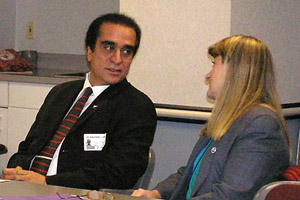CREST & NOAA's STAR Meetings Held December 7-8, 2009

Reza Khanbilvardi & Mary Kicza
Decadal Environmental Remote Sensing
Science & Technology:
NESDIS & CREST Visions
December 15, 2009 - On December 7-8, 2009, seventy
scientists from NOAA and affiliated universities of the NOAA-CREST
Cooperative Science Center attended the 2nd Joint Technical Meeting
held at NOAA in Silver Spring, MD. The two-day meeting highlighted the
significant accomplishments and partnerships that have developed
between CREST and NOAA particularly with NOAA's Center for Satellite
Applications and Research (STAR) since the first joint CREST-STAR
technical meeting held in Camp Springs, MD, on February 24-25,
2003.
The morning plenary session of the first day began with the welcome
remarks from Ms. Mary Kicza, NOAA Assistant Administrator for
Satellite and Information Services, followed by overview presentations
on NOAA/NESDIS/STAR's 10 year outlook and the CREST research,
education, and capacity building. CREST thematic area and NESDIS/STAR
research overview presentations continued during the afternoon of the
first day. The presentations comprised the CREST related research
clusters/themes as aligned with NOAA's current missions and goals
including: Climate and Air Quality; Coastal Remote Sensing;
Land/Terrestrial Precipitation, Soil Moisture & Water Resources;
Severe Weather and Hazards; and Education; Outreach and Professional
Development. The day concluded with a group dinner in a local Silver
Spring restaurant.
The second day began with several break-out sessions by thematic
area to discuss the expansion of research and educational
collaborations between NOAA and CREST. All groups reconvened after the
lunch to share the results of these breakout sessions to discuss and
develop a comprehensive list of action items for sustainable
partnership between NOAA particularly NESDIS/STAR and CREST for the
next decade.
The overarching goals and objectives of the meeting were:
- Discuss and expand the long existing partnership between NOAA
particularly NESDIS/STAR and CREST;
- Understand NESDIS' science & education goals;
- Review overall CREST program and its accomplishments;
- Leverage/explore new opportunities (research; education &
outreach and professional development);
- Expand existing NESDIS/STAR-CREST collaborations;
- Increase CREST student mentoring by NOAA scientists;
- Create opportunities for NOAA/NESDIS scientists visit/exchange
with CREST; and
- Increase opportunities for joint seminars/webinars and short-
courses for CREST students, and teacher training.
|



